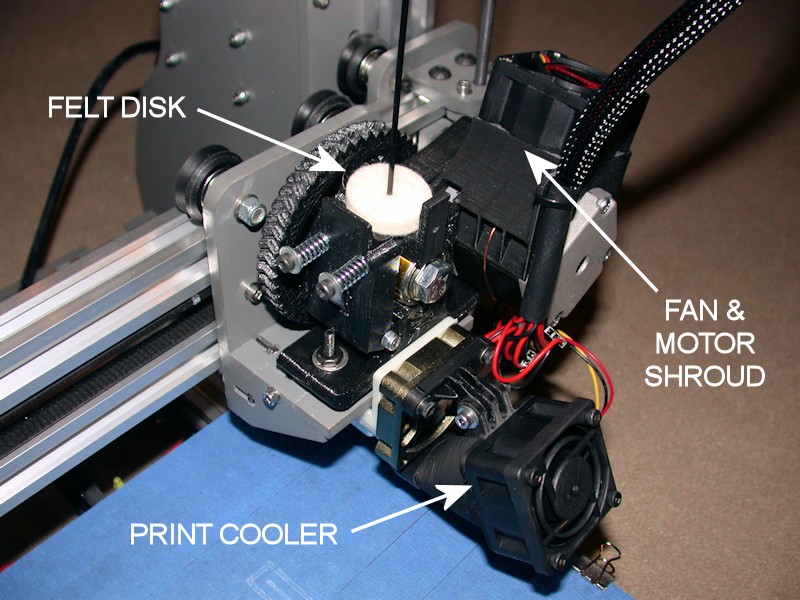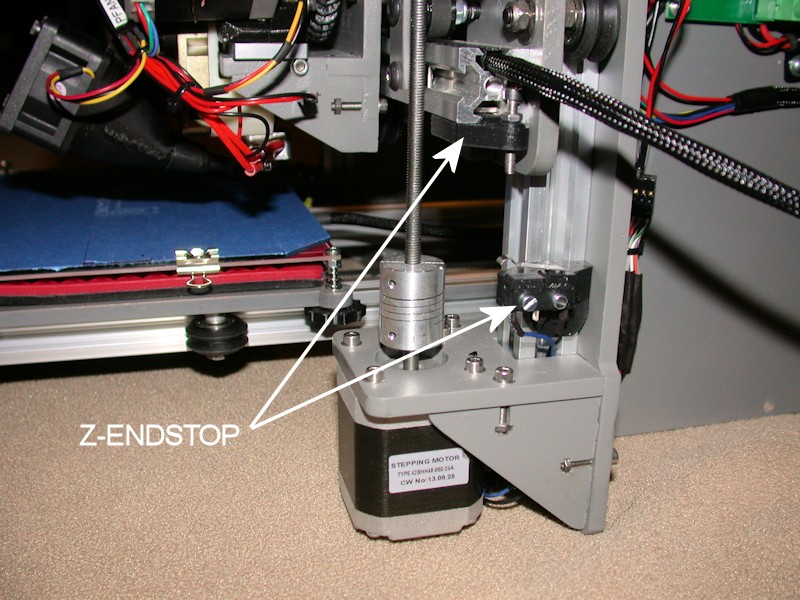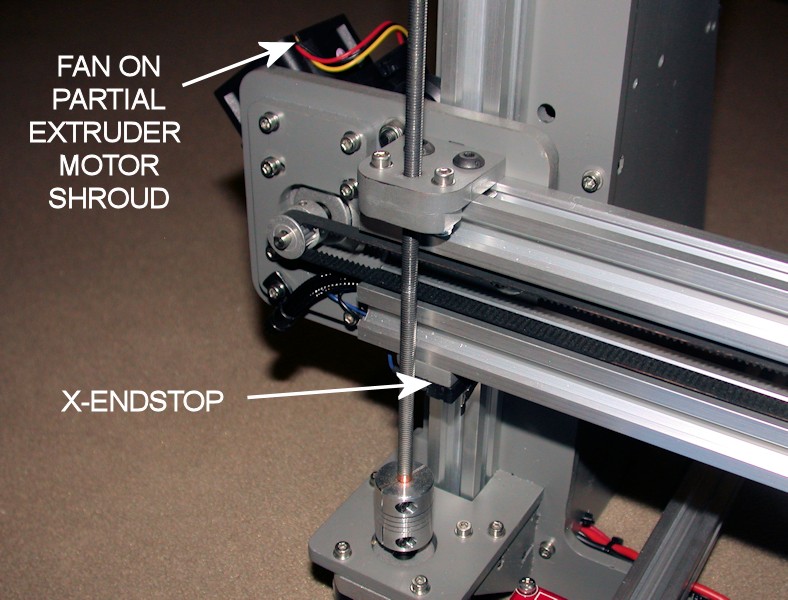Results 1 to 10 of 255
Threaded View
-
07-31-2014, 01:19 PM #10
SIX WEEK STATUS UPDATE
After about five dozen prints, I'm still content with my decision to go with the i3v. Primarily thanks to Thingiverse, I've pretty much got the hardware where I want it to be for now...

SLICER
After futzing and researching, I've opted to focus on Cura as my slicer. Working with both v0.9.9 and v1.1.6 in Slic3r, I just grew increasingly frustrated with gcode conversion taking so long or not completing, with some prints having gaps left behind while on other prints excessive time seemed to be spent on gap/hole touchup, with nozzle moves that do not follow logic, with some prints coming out better in v0.9.9 while others did better in v1.1.6, and with support capability still being somewhat lacking. Some of these issues may be user error in dealing with the 100+ settings in Slic3r, and at some point I may want that detail of control back, but for now I'm doing great with the subset of controls Cura provides.
FOLLOWUP COMMENT: When Repetier baselined Cura as an integrated slicer, I migrated to that. I'm liking it. It provides a nice interface that integrates printer manual control, slicing, layer by layer review of the slicing result, printing, and layer-by-layer monitoring of what the printer is doing.
PRINT SURFACE
With the hairspray-on-glass surface I had been using, I battled getting the first layer of PLA to stick with Cura. At all. Research indicated others have also had first-layer problems when switching to Cura. Changing pertinent settings and moving to printing on blue painter's tape with no heat applied helped, but not enough. For me, the magic combination seemed to be the settings and blue tape, along with wiping the painter's tape down with isopropyl alcohol after installing it and then adjusting the nozzle clearance with the nozzle hot. I wasn't expecting to have to re-engineer the first layer approach just because I went to a different slicer. There's definitely a difference in how the first layer is handled.
LEVERAGING THINGIVERSE AND OTHER MODS
So far, I'm not into designing my own stuff to print. I'm busy enough with just figuring out the printing side of things. Here are the things I've incorporated into the i3v...
I swapped out the original thumbwheels under the heat bed with ones that have more knurl - http://www.thingiverse.com/thing:29782. The one at the rear left corner was filed down just a bit to clear the frame side wall. To recap, on my printer all four corners of the heat bed are adjustable. Screws are locked to the heat bed, and the thumbwheels go under the Y-bed. It takes about a minute for me to check and adjust level around the bed. I'm currently seeing no issues driving me to incorporate automatic bed leveling.
FOLLOWUP COMMENT: A side benefit to these thumbwheels is that they have 10 ridges around the circumference. At 0.5mm pitch on the M3 screw they are mounted on, each notch in rotation equates to a 0.05mm height adjustment in that corner.
I swapped out the LCD knob with one that just looked better - http://www.thingiverse.com/thing:385882
For a spool mount, I migrated to brackets that hold the spool directly above the top plate on the i3/i3v - http://www.thingiverse.com/thing:192510. There are multiple bracket designs that hang the spool to the rear, but I didn't like the idea of that weight putting torque on the top plate. The spool I have from MakerFarm with 1.5-inch spindle got a pair of these hubs with bearings - http://www.thingiverse.com/thing:7853. My other spools with dual-size spindles use prints derived from http://www.thingiverse.com/thing:28046.
FOLLOWUP COMMENT: I found there's a side benefit to the spool being on a wide rod. I ended up with shaft collars on each side of the spool, and the shaft collars are tightened to the rod. I can adjust the spacing of the shaft collars to put just a bit of drag on the spool. This has been really helpful in keeping the windings on the spool layered properly. I found that if the spool spins too freely, the spool can start to unwind itself and loosen up several turns of filament. This could eventually lead to feed issues.
It's not Thingiversed, but I now print the cooling shroud for the hex hot end in ABS so I can easily cut out the bottom of it to clear the nozzle body of the hot end. Whose idea was it to have the printed cooling shroud snap onto the hot end and rest on the aluminum block where, um, PLA and ABS gets melted? I added some kapton tape to the top surface of the hot end block to help insulate the block from the hex cooling fan airflow. I also swapped out the noisy hot end fan MakerFarm with a quieter one. The first one was around 5 CFM but super quiet. This was OK with PLA, but the extruder base started getting soft when I started working with the higher temperatures of ABS. The current fan is only spec'd at about 6 CFM, but has a higher speed that can probably do better at pulling air through the shroud.
FOLLOWUP COMMENT: I later added wings to the rear of the shroud to ensure airflow is forced onto the hot end heatsink. See EXTRUDER REBUILD AND NEW PRINT COOLER (Part 1).
In the original build, I futzed with the X and Y idler alignment so that belts wouldn't drift to the side and rub against the wood of the mounting brackets. I no longer had a problem to solve, but as a design improvement I printed and installed a pair of these belt guides - http://www.thingiverse.com/thing:359773. I installed them with three washers - one on each side and one used as a spacer between the two bearings that press into the belt guides. The belt lengths needed to be increased a few teeth, but I had left enough excess length before to cover this.
Clough42 has a pretty slick cooling shroud for adding a 40mm cooling fan to the extruder motor - http://www.thingiverse.com/thing:343026. I'm using a fan that doesn't put through the air that the one in his Thingiverse picture does, but I used what I could find locally and wanted to lean towards the quiet side as a starting point. Rather than cover some of the motor metal with a zip tie to strap on the shroud, I used a loop of solid wire as an attachment in addition to the snug fit the shroud already has on the motor. While the design is great, as a non-expert I found it to be one of my more challenging prints to date. Six or eight attempts ended up in the trash. One, the grid that faces the motor appears to not show up until the second layer (although I did get some gcode from Slic3r 0.9.9 that included it in the first layer), and many prints would start out bad because of this. Two, one side of the shroud has a pretty good slope to it that I found challenging. Three, I'd typically end up grinding into the filament when the end was near and I'd only be adding small layers to the "uprights" in the print structure. I'm sure the latter issues were my own doing - especially my retraction settings. I printed another after getting Cura somewhat figured out and a print cooler installed - that print turned out far better, first shot.
FOLLOWUP COMMENT: I have the motor type that runs hot. A cooling fan for the extruder stepper motor may not be required by all MakerFarm kits.
FOLLOWUP COMMENT #2: In EXTRUDER REBUILD AND NEW PRINT COOLER (Part 1), I ultimately replace the hot-running motor with a different one.
Filament now passes through a Dremel "felt polishing wheel" added to the top of the extruder to wipe the filament clean. This was added after I found the need to unroll quite a length of filament to remove some twists showing up towards the end of a spool of white filament. Enough of the filament was unrolled that it ended up on the floor. My print area has black and dark grey commercial carpet, and we have two black cats and a small dog with short black hair that hang out in the same area. Need I say more?
I've incorporated Clough42's print cooler - http://www.thingiverse.com/thing:351280. It fits best without the stock hex hot end cooling shroud and fan in place, but my glued-together X-carriage and undermounted LED lighting doesn't lend to incorporating his alternate hex hot end cooling system, and I'm not sure the alternate system will handle cooling for ABS. I just mounted it in addition to the hot end shroud and fan, and I've been playing with extending the print cooling shroud with large heatshrink. My PLA prints are definitely coming out better with this. I tried a couple different fans, and ended up sticking with an Adda fan with 10 CFM at 7800 RPM. The lower RPM isn't too obnoxious at full speed, even though the speed can usually be dialed back either via the slicer setup, LCD, or Pronterface/Repetier Host type software.
FOLLOWUP COMMENT: I've since removed the print cooler. Mounted on top of the hex hot end fan, it was likely blocking some of the hot end fan airflow. Combined with the low-flow fan I had on the hot end, this allowed the extruder base to soften up when I started printing at higher temps for ABS. So, I removed the print cooler and also put a stronger fan on the hex hot end.
FOLLOWUP COMMENT #2: The new print cooler approach is discussed in EXTRUDER REBUILD AND NEW PRINT COOLER (Part 2).

With a hefty pat on the back, Clough42 also has a replacement design for the irksome 8-inch i3v Z-endstop - http://www.thingiverse.com/thing:336665. This includes a new v-rail bracket for mounting the endstop switch on the right-side vertical rail, and a screw-adjustment bracket that mounts to the lower X-axis rail. Very cool and very functional. He also has printable brackets for the X/Y switches, but I've left mine wood for now.

One of the attempts at the extruder motor cooling shroud completed just enough that I could use it on the X-motor. It was either use it there or throw it away. The full length print would interfere with the delrin wheel(s) on the X-motor plate. I think this one stopped extruding at about the 85% point.
FOLLOWUP COMMENT: I have the motor type that runs hot. The temperature of the X-motor may not be an issue on all MakerFarm kits.
Finally, I swapped things around so that "home" is now in the forward-left corner of the print bed. This makes it easier to clean off the nozzle just before a print starts, and the print bed orientation is now the same as it is in the slicer and in Pronterface. There's firmware magic that could have done this, but for now I just moved the locations of the X and Y endstops and reversed the X/Y motor plugs on the RAMPS board. The revised Y-endstop uses the same post sticking down from the heat bed - the switch was relocated to just in front of the Y-motor. The X-endstop got moved to the left side of the printer. IIRC, both switches had to be moved to the other side of the mounting brackets. I've set up CURA to include endcode that brings the bed forward and moves the X carriage to the far right at the end of a print.

SPARE PRINTED PARTS
Only now do I think I've learned enough about printing and managing print quality to consider printing spare parts for the extruder. I've been on borrowed time with the extruder base that had started to split (note the large washer and nut that isn't supposed to on the extruder mounting bolt in the extruder picture).
FIRMWARE
I'm still running the firmware as supplied my MakerFarm. I haven't even enabled making EEPROM changes from the LCD, so I have to manually set the extruder feed rate all the time. This has actually been intentional for my situation. I've done a number of AVR-based microcontroller projects before, and I've seen a lot of forum-code and open-source stuff that really didn't have a lot of quality to it, especially in the Arduino world. I'm not saying that's true of the Marlin/RAMPS stuff - I certainly hope it's not the case. But by not even downloading the source code, I haven't been tempted to start "tweaking" it under the assumption that I thought I could do better.Last edited by printbus; 05-03-2015 at 07:34 AM. Reason: migrated to offsite image storage due to 3DPrintBoard issues







 Reply With Quote
Reply With Quote




Please explain to me how to...
Yesterday, 12:15 PM in 3D Printer Parts, Filament & Materials